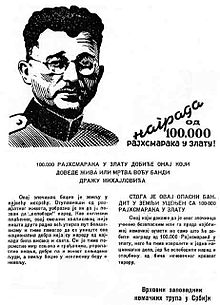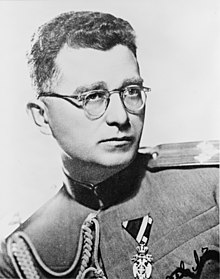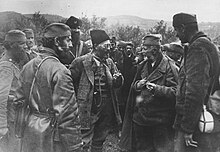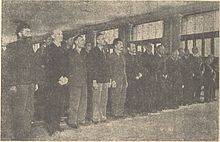Draža Mihailović
Dragoljub Mihailovic ( Serbian - Cyrillic Драгољуб Михаиловић * 27. April 1893 in Ivanjica , Kingdom of Serbia ; † 17th July 1946 in Belgrade , Federal Republic of Yugoslavia ), called " Draža " (Дража), was a royal Yugoslav general staff officer and Chetnik - Leader during the Second World War . As such, the royal Yugoslav government- in - exile in London appointed him Minister of War in 1941 and legalized the Chetniks as the so-called “ Yugoslav Army in the Fatherland ”. He held his office until 1943, but in fact never exercised it .
As a Yugoslav monarchist and Serbian nationalist , Mihailović sought to reestablish the Kingdom of Yugoslavia and to establish Greater Yugoslavia with an ethnically pure Greater Serbia that would also include Macedonia , Kosovo , Montenegro , Bosnia , Herzegovina , Syrmia , the Banat and the Batschka .
After the war, he was charged by the Yugoslav authorities as a collaborator and war criminal and executed.
In May 2015, Mihailović was rehabilitated after a controversial ruling by the Supreme Court of Cassation, the highest court of appeal in Serbia.
Life
Military career
Mihailović was born in 1893 to Mihailo and Smiljana, née Petrović, near the town of Čačak in the Kingdom of Serbia . From the Serbian Military Academy he moved to the Balkan Wars of 1912 and 1913. During World War I , Mihailović was stationed in Albania and on the Salonika Front. He completed his training at the military academy after the war and was assigned to various staff departments . Between 1935 and 1937 he served as a military attaché in Sofia and Prague . He then worked in several staff positions and taught, among other things, infantry tactics at the military academy . From 1939 his interest shifted from infantry to guerrilla warfare , which had a tradition in the areas of Yugoslavia formerly occupied by the Ottoman Empire ( Serbia , Montenegro , Macedonia , Herzegovina , Bosnia ) and had been waged by Chetniks and Komitaji . Mihailović prepared a report on the reorganization of the Yugoslav army for the then Yugoslav War Minister Milan Nedić . In it, Mihailović advocated a principle of nationally homogeneous military units. He also proposed as a defense concept to abandon the difficult-to-defend northern lowlands of Yugoslavia and to concentrate defense on the mountainous parts of the country. Mihailović's proposal was rejected by Nedić, but Mihailović remained in charge of guerrilla warfare issues as chief of operations in the General Staff . In 1940 Mihailović was contacted by the British secret service in Belgrade as an informant about the position of the Yugoslav army in a possible coup against the Yugoslav king. However , Mihailović was not involved in the 1941 Yugoslav coup d'état carried out by the military .
Chetnik leader in World War II
Establishment of Chetnik associations
When the German Wehrmacht attacked Yugoslavia , Mihailović was a colonel in command of a motorized division in eastern Bosnia. When he learned of the surrender of the Yugoslav armed forces, he withdrew to the Bosnian forests with a small part of the force consisting entirely of Serbs . On the way to central Serbia, Mihailović's troops were involved in battles with a German unit near Užice on May 6, 1941 , and were almost wiped out. With seven officers and 27 soldiers he reached his future headquarters in the Ravna Gora on May 13, 1941 after a march of several weeks towards Serbia . Mihailović's Chetnik movement is also known as Ravnogorski pokret (Ravna Gora movement) after this ridge near his birthplace . In the course of the war, the Chetnik units also included Slovenian units (so-called “blue guards”), a Croatian battalion and Bosniaks .
Political goals
Mihailović advocated the continuation of the Kingdom of Yugoslavia under the leadership of Serbia. In the event that Yugoslavia should fail, he spoke out in favor of a Serbia within the borders before the proclamation of Yugoslavia in December 1918, with Macedonia and Montenegro. Croatia was to get its borders after the Serbian-Croatian Compromise ( Sporazum Cvetković– Maček ) of 1939, ie about a third of Bosnia-Herzegovina next to Croatia, exactly as it was before the war. After realizing the extent of the crimes committed by the Ustaše, Mihailović came to the conclusion that territories should be taken from Croatia. So the Croatian areas of that time should be distributed as follows: Syrmia , Baranja and eastern Herzegovina to Serbia, and southern Dalmatia to Bosnia. Bosnia was then to decide in a referendum whether it wanted to join Serbia, whereby the outcome of such a referendum was predictable through the previous territorial distribution, since the majority of the population in rump Bosnia was Serbian and therefore a connection of Bosnia with the now attached southern Dalmatia to Serbia would have agreed. De facto , this would have meant the establishment of a Greater Serbia , as was also called for by the Serbian lawyer Stevan Moljević from Banja Luka, political leader of the Chetnik movement and adviser to Mihailović since 1943.
Relationship with the occupiers
After initial cooperation with the communist partisans led by Tito , who advocated a new socialist order in post-war Yugoslavia, there were more and more clashes between the two resistance movements. From 1942 this ended in open hostility, in the course of which Mihailović cooperated more and more openly with the Italian and later also with the German occupiers.
Mihailović tried, in agreement with the Nedić government, to legalize the Chetnik associations in Serbia. He made some units available to Nedić and was unofficially supported by him with money, food and clothing. At the same time, Mihailović tried to use his channels to suggest to the British government that “he was the only resistance leader in Serbia”. Mihailović expected the Germans to be tolerated because of his services in the fight against the partisans.
On the orders of Hitler on September 16, 1941, the German occupation forces retaliated for fighting by the rebellious Mihailović Chetniks and communists. The aim was to kill a hundred Serb hostages for one German soldier killed, fifty for each injured. If it was not possible to determine whose movement was responsible for an act of sabotage or terrorism, an equal number of Mihailović supporters and communists were executed, mostly by hanging or shooting .
After the destruction of the partisan stronghold of Užice by a German division under the command of General Böhme in November 1941, the occupiers turned to Mihailović's movement. On December 7, 1941, the German 342nd Infantry Division attacked the Chetnik headquarters in Ravna Gora, killing 10 Chetniks and taking 390 prisoners. Mihailović himself was able to escape captivity. The Yugoslav exile King Peter II appointed Mihailović from London on December 7, 1941 as brigadier general and leader of the "Yugoslav Home Army", which was rather symbolic in view of the massive military losses of the army of the Kingdom of Yugoslavia and the complete occupation of Serbia. Until the end of the war, the Chetnik movement was unable to gain a foothold in Serbia. Only a small number of his people managed to carry out minor acts of sabotage.

In an order from the Southeast Command of July 10, 1942 to General Paul Bader , the military commander in Serbia , it is stated that Mihailović was "the most dangerous enemy". His movement should not be allowed any room for development, an unification of the Chetnik gangs should be prevented at all costs. On July 20, 1942, General Bader had a profile published in which Mihailović, dead or alive, was offered 100,000 Reichsmarks. A day later, an almost identical wanted poster appeared, which was used to search for Tito . "Reichsführer" Heinrich Himmler was also involved in the hunt for Mihailović . In July 1942 he ordered the police to find the whereabouts of Mihailović and his staff in order to destroy them.
It was only in the summer of 1942 that Mihailović managed to regain influence in Montenegro and Herzegovina. However, he refused fighting and acts of sabotage against the Germans and collaborated with the Italians until their surrender in autumn 1943.
In the summer and autumn of 1942 there were increasing acts of sabotage by some Chetnik troops on railway lines, bridges and trains in Serbia, and movements of trains were also reported to the British secret service. These efforts were intended to hinder Erwin Rommel 's campaign in Africa, because the supply route for Army Group Africa ran through Yugoslavia and Italy, so that the Chetniks' actions were of particular importance. On August 8, 1942, Draža Mihailović notified the British command in the Middle East that sabotage would take place on a large scale along railway lines in Serbia. His orders to some of his commanders, however, were intercepted by German eavesdropping specialists and reported in a report, with the comment that General Mihailović had probably taken a definitive stand against the occupying power with these orders.
The response to Mihailović's behavior was ruthless. On August 28, 1942, the Austrian general Alexander Löhr was appointed as the new commander of the Southeast Command. In a major arrest operation, several suspected Mihailović agents who worked for the Serbian authorities were arrested. Then began a campaign against bases of Mihailovićs JVUO on Ravna Gora and in the Kopaonik Mountains. For this purpose, the 7th SS Volunteer Mountain Division “Prinz Eugen” was set up, in which mostly ethnic Germans from the Banat served. The division was involved in fighting against Mihailović's Chetnik units for the next three months. On October 12, 1942, the attack against bases of the JVUO at Guča began , with the aim of capturing Mihailović. But it soon turned out that he had fled to Montenegro before the attack , so that the planned capture failed. The Chetnik troops withdrew from the attack, while civilians experienced the anger and disappointment of the occupiers. Jews and Gypsies in particular suffered from the retaliation of the Wehrmacht. In the autumn of 1941, General Böhme ordered the shooting of 2,200 Jews for the German losses at Topola. At that time, 8,000 male Jews were imprisoned in Serbian concentration camps, waiting to be shot “on demand”.
On November 7, 1942, Mihailović called on the Serbian people to civilly disobey the occupiers. Fear of retribution, few responded to the call. In response, General Bader announced that every act of sabotage would be answered with the shooting of hostages and the destruction of villages along the railway lines. In addition, 50 Serbian hostages were to be killed for every German, ethnic German or member of the Bulgarian occupation forces killed or missing. For every member of the Serbian Nedić government and every Serbian official killed, 100 hostages were to be killed.
On February 9, 1943, the Army High Command published a “Handbook on the Draža Mihailović's Movement”, in which Mihailović's Chetniks were characterized as “Greater Serbian combat units” that carried out terror in the Balkans and killed innocent Croats and Bosniaks. According to the manual, Mihailović's following comprised 80% of the Serbian people and had a combat strength of 150,000 men. His troops knew the combat area very well and enjoyed great popular support.
At the beginning of July 1943, General Bader learned from the intelligence department of the German command in Serbia that Mihailović was staying in a village near Čačak . Thereupon Bader organized the “Operation Morgenluft” in the strictest secrecy, in which German and Bulgarian troops took part. In the course of this operation, 11 Chetniks were killed and 453 captured, but Mihailović escaped again. General Bader broke off the operation and doubted the continued success of the search because the enemy had been warned in good time about major search operations through his extensive espionage network.
The End
At the beginning of April 1945, General Löhr Mihailović made an offer to take him across the German border to what was then the Alpine and Danube Reichsgaue so that he could face the British. Mihailović refused the offer and decided to leave for Serbia with about 12,000 men in order to overthrow the communist government. But the project failed and on May 12, 1945 his troops were provided by the Yugoslav army , around 9,000 Chetniks were killed in the battle of Kalinović . Mihailović himself was able to flee one last time.
On March 13, 1946, Mihailović was finally arrested in the Serbian-Bosnian border area by the Yugoslav secret service OZNA . Nikola Kalabić , one of Mihailović's commanders, had betrayed him and led OZNA agents disguised as Chetniks into his hiding place. While in detention, Mihailović asked to have his beard shaved off. This request was not met because they wanted to see him with his trademark in court for the stronger effect. On June 10, 1946, the trial of Mihailović and 24 other co-defendants, mainly for war crimes and collaboration , opened before a Yugoslav military court . From abroad Mihailovic was offered the well-known lawyer Morris Ernst (USA) as a defense attorney. Mihailović refused this offer and trusted his defense lawyers and the court. The decision in the process came after Mihailović, cornered by conclusive documents, admitted to having worked with the German occupying forces. On July 15, 1946 Mihailović was sentenced to death with nine other accused . Mihailović's appeal for clemency on July 16 was rejected and on July 17, 1946, the sentence was carried out in Belgrade by firing squad . The place of execution and burial site were kept secret by law.
In 2005, the Serbian weekly Danas interviewed an eyewitness to Mihailović's execution, NCO Ljubo Lazarevski. During the trial he was responsible for guarding Mihailović and the other defendants and guarding them until they were handed over to the firing squad. He revealed many details about the process leading up to the execution and he even secretly observed the shooting. According to his account, Mihailović and the nine other people sentenced to death were shot in a forest near the former royal palace " Beli Dvor " (White Court) and buried in prepared pits. The authorities later guarded the area without telling the guards the real reason.
Voices about Mihailović

Yugoslavia
In socialist Yugoslavia after the Second World War, Mihailović's movement was branded as retrograde, treasonous and criminal by the rulers of the Communist Party, not least for political and ideological reasons. The crimes committed by communist partisans against Mihailović's supporters during the war (e.g. during the “ Bleiburg massacre ”) were not officially an issue at the time.
Tito's biographer and comrade-in-arms against the Chetniks, Vladimir Dedijer , wrote that Mihailović had pursued “the cleansing of the national territory from all ethnic minorities and non-national elements” as well as “common Serbian-Montenegrin and Serbian-Slovenian borders, whereby the Sandžak of Muslim and Bosnia was pursued of the Muslim and Croatian population ”.
Milovan Djilas was briefly involved in the preparations for the trial against Mihailović as Deputy Minister of the Interior (on behalf of Aleksandar Ranković ), met the prosecutor Miloš Minić and, due to his political position, followed the course of the trial in detail. After his break with Tito, the dissident Djilas said of Mihailović:
“A traditionalist, unable to grasp the stormy time, let alone navigate through it. For Draža the people, especially the Serbian, were inviolably religious and patriotic, devoted to the king in a good-natured way and oriented towards small property. There was a tendency for the military to play an authoritarian role in him, and even more so in those around him, but basically he was more inclined to bourgeois liberalism than to dictatorship. His devotion to the king and the monarchy stems more from his loyalty to the oath and tradition than from a mature political and philosophical doctrine . Otherwise he had few firm or clear ideas; even his Yugoslavism was inconsistent and changeable, not only because of his Greater Serbian attitude, but also because of his own fickleness. Although his units, sometimes on his orders, perpetrated mass crimes against the non-Serbian population and brutally persecuted and exterminated communists and their sympathizers in a blind rage, Draža was considered neither cruel nor fanatical. "
United States

In a letter dated October 14, 1942, the then US President Franklin D. Roosevelt commented positively on Mihailović and praised his exemplary courage, which was expressed in the resistance against the occupiers. Roosevelt saw Mihailović's struggle as an important contribution to the Allied victory. He proposed dividing rule over a future Yugoslavia between Tito and Mihailović. In 1942, the US American General Dwight D. Eisenhower conveyed his “comrade in arms” Mihailović the best wishes and greetings from the US armed forces in Europe and the USA.
From the point of view of the conservative American journalist Mary Mostert, Draža Mihailović is a "hero" of the Second World War. "Few Americans, especially young ones, have ever heard of Mihailović and his men, who at high risk saved the lives of over 500 Americans and 250 allies behind enemy lines." This had been covered up for political reasons, because British Prime Minister Winston Churchill for the Communist partisans under Tito took sides. During the Second World War, Mihailović's Chetniks rescued 432 Allied pilots who had been shot down over Yugoslavia. The pilots were given accommodation in the Chetniks' hiding places and were fed. For this, the then President of the USA Harry S. Truman , on March 29, 1948, posthumously awarded Mihailović the Legion of Merit , a military medal with which the USA honors foreigners for "particularly meritorious behavior in the execution of outstanding services for the United States". The award was kept secret until 1966. A US delegation presented the medal to Mihailović's daughter in Belgrade in 2005. Among those rescued was Major Richard Felman, who in 1994 spoke of "the greatest operation to save American lives from enemy territory in the history of war".
Great Britain
Anthony Eden , then Foreign Minister of Great Britain, spoke on the occasion of the Yugoslav national holiday on September 14, 1942 that a regular Yugoslav army under the leadership of the great hero General Mihailović was fighting the enemy on the territory of Serbia.
Awards
- Medal of Bravery (Soviet Union) , twice
- Alexander Nevsky Order (Bulgaria), Grade III
- St. Alexander Order (Bulgaria)
- Virtuti Militari (Poland)
- Order of the White Lion (Czechoslovakia), grade III
- Military Cross (United Kingdom)
- 1918: Order of the White Eagle (Serbia) , grade V
- 1920: Order of the White Eagle (Serbia), grade IV
- 1928: Order of St. Sava (Serbia), grade IV
- 1933: Order of the Crown of Yugoslavia (Kingdom of Yugoslavia), grade IV
- 1943: Croix de guerre (France)
- 1948: Legion of Merit (USA), posthumously
Others
In 1943 a comic book entitled Liberty for the Chetniks was published from the Captain Marvel Jr. comic series .
literature
- Jozo Tomasevich: The Chetniks: War and Revolution in Yugoslavia, 1941–1945 . Stanford University Press, Stanford 1975, ISBN 0-8047-0857-6 .
- Matteo J. Milazzo: The Chetnik Movement and the Yugoslav Resistance . Johns Hopkins University Press, Baltimore 1975, ISBN 0-8018-1589-4 .
- Holm Sundhaussen: Mihailović, Draža Dragoljub . In: Biographical Lexicon on the History of Southeast Europe . Volume 3. Munich 1979, pp. 196-198
- Lucien Karchmar: Draža Mihailović and the Rise of the Cetnik Movement, 1941–1942 . Garland Publishing Inc., New York / London 1987, ISBN 0-8240-8027-0 .
- Simon Trew: Britain, Mihailovic and the Chetniks, 1941–42 . Studies in Military and Strategic History. Palgrave Macmillan, Basingstoke 1998, ISBN 0-333-69589-5 .
Web links
- Literature by and about Draža Mihailović in the catalog of the German National Library
- Draža Mihailović in the Munzinger archive ( beginning of article freely available)
- The Trial Of Dragoljub-Draza Mihailovic (English)
- Australian Government - Historical Publications on Mihailović (English)
- La Yougoslavie livrée au communisme par ses alliés: 1941 - 1945 ( Memento of May 4, 2006 in the Internet Archive ) (French)
Individual evidence
- ↑ Mostly called Čiča Draža (Uncle Draža) by sympathizers , see http://www.novosti.rs/vesti/naslovna/aktuelno.293.html:389487-Cica-Draza-stize-u-Beograd-i-Vasington
- ↑ Holm Sundhaussen : History of Serbia: 19. – 21. Century . Böhlau Verlag, Vienna a. a. 2007, ISBN 978-3-205-77660-4 , pp. 321 .
- ^ Michael Portmann, Arnold Suppan: Serbia and Montenegro in World War II . In: Österreichisches Ost- und Südosteuropa-Institut (Ed.): Serbia and Montenegro: Space and Population, History, Language and Literature, Culture, Politics, Society, Economy, Law . Lit Verlag, Münster 2006, ISBN 3-8258-9539-4 , p. 287 f .
- ↑ Cultures of History Forum (Friedrich Schiller University Jena): Twice Before the Court: The Judicial Rehabilitation of General Dragoljub Mihailović , October 30, 2017, accessed on October 13, 2019.
- ^ The Trial of Dragoljub-Draža Mihailović: Stenographic Record and Documents from the Trial of Dragoljub-Draža Mihailović . Belgrade 1946, p. 13 .
- ^ Walter Manoschek : Serbia is free of Jews: Military occupation policy and the extermination of Jews in Serbia 1941/42 (= contributions to military history . Volume 38 ). Oldenbourg Verlag, Munich 1993, p. 112 .
- ^ A b Jozo Tomasevich: The Chetniks: War and Revolution in Yugoslavia, 1941–1945 . Stanford University Press, Stanford 1975, ISBN 0-8047-0857-6 , pp. 122 .
- ^ Walter Manoschek : Serbia is free of Jews: Military occupation policy and the extermination of Jews in Serbia 1941/42 (= contributions to military history . Volume 38 ). Oldenbourg Verlag, Munich 1993, p. 112 .
- ^ Noel Malcolm: History of Bosnia . S. 210 f .
- ^ A b Walter Manoschek: Serbia is free of Jews: Military occupation policy and the extermination of Jews in Serbia 1941/42 (= contributions to military history . Volume 38 ). Oldenbourg Verlag, Munich 1993, p. 152 .
- ↑ Milovan Djilas: Years of Power: Play of forces behind the Iron Curtain: Memoirs 1945–1966 . Molden, 1983, ISBN 3-88919-008-1 , p. 51.
- ↑ Milovan Djilas: Years of Power: Play of forces behind the Iron Curtain: Memoirs 1945–1966 . Molden, 1983, ISBN 3-88919-008-1 , p. 53 f.
- ↑ Milovan Djilas: Years of Power: Play of forces behind the Iron Curtain: Memoirs 1945–1966 . Molden, 1983, ISBN 3-88919-008-1 , p. 52 f.
- ^ Walter R. Roberts: Tito, Mihailović, and the Allies, 1941-1945. Rutgers University Press, 1973, p. 166.
- ^ Frank C. Foster: United States Army Medals, Badges and Insignia . Medals of American Press, 2011, ISBN 978-1-884452-67-3 , p. 127.
| personal data | |
|---|---|
| SURNAME | Mihailović, Draža |
| ALTERNATIVE NAMES | Mihailović, Dragoljub |
| BRIEF DESCRIPTION | Yugoslav officer and Chetnik leader |
| DATE OF BIRTH | April 27, 1893 |
| PLACE OF BIRTH | Ivanjica , Serbia |
| DATE OF DEATH | July 17, 1946 |
| Place of death | Belgrade |





